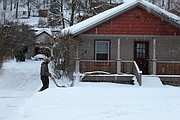Arctic blast causes severe issues
Last week Western Montana watched as the thermometers dipped well below zero, as an arctic blast covered the area. According to reports, a record low was set on Jan. 3 in Missoula when temperatures dropped to minus-8 degrees. The lowest recorded temperature prior to this was 3 degrees set in 1959.
On Monday, Jan. 2, three local ski areas were forced to close due to the extreme cold and wind. Snowbowl located near Missoula, Discovery Ski Area near Philipsburg, and Blacktail Mountain near Lakeside were all shut down because it was unsafe for skiers.
At Snowbowl, the National Weather Service reported minus-10 degrees, with winds up to 30 mph. This caused windchills of minus-43 degrees. Skiers at Lost Trail near Darby, said the top of the mountain was closed, with windchills also dropping to minus-30 degrees.
These temperatures can be very dangerous, for example the first signs of frostbite can occur in as little as five minutes when skin is exposed at minus-32 degrees.
This cold wave blanketed the area all week, with the reader-board at Alberton School not topping 4 degrees on Thursday, Jan. 5. St. Regis School also succumbed to the cold on Thursday when the building lost its heat. School Superintendent Joe Steele reported that the vaporizer on the propane tanks “is shot” which caused it to freeze up when it gets extremely cold. They were able to get the school’s old boiler running and so school resumed on Friday. Steele said they also suffered some water pipe breaks due to the weather.
Around the area, there were concerns about “freeze-up ice jams.” National Weather Service Hydrologist Ray Nickless reported a number of ice jams growing quickly, including one on the Clark Fork River, extending east of Missoula to Drummond.
He said with the extended arctic air mass, it will continue to grow. Then, if temperatures warm too fast, flooding may occur. According to Jim Ward with the Forest Service, there are no reported ice jams on the Clark Fork River in Mineral County.
“Although there is impressive ice forming on the Clark Fork and its tributaries, we have not identified any specific near-term concerns, nor have we had any reported so far. We will continue to monitor the waterways and the weather to see if conditions develop that warrant imminent concerns,” he said.
The weather on Thursday also turned deadly when Ben Parsons, 36, died from trauma sustained after he was caught in an avalanche in Glacier National Park while backcountry skiing. The slide occurred about 500 feet below the summit on Stanton Mountain, according to reports from last week.
Avalanche danger continues to plague Western Montana. On Sunday evening Idaho transportation closed Highway 12 on the Idaho side from mile marker 126 to 139 due to avalanche danger. It was still closed as of Monday, Jan. 9.
Also on Sunday evening, the Missoula County Sheriff’s Department requested only emergency travel in Missoula County and on Interstate 90 due to treacherous driving conditions. Since Jan. 2, there were 37 incidents reported on I-90 in Mineral County through the morning of Jan. 9, with no serious injuries. Twelve of those incidents were reported on Jan. 8.
On Monday, both St. Regis and Superior schools were closed due to hazardous conditions, along with schools in the Bitterroot. Bonner, Frenchtown and Potomac schools were delayed two hours. Alberton School opened at its regular time.
Additionally, two snow slides struck Mineral County’s stretch of I-90 on Monday. One was near mile marker 8, about two miles west of Taft, the other was near Lookout Pass.





